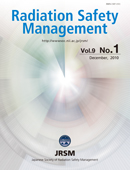Radioactive waste generated from research laboratories and other facilities is regulated by the Law Concerning Prevention from Radiation Hazards due to Radioisotopes etc. (Prevention Law). However, the Prevention Law does not provide the level of clearance or the procedures to follow for compliance monitoring. To assess radioactivity amounts for making decisions about clearance levels, the radioactivity levels in dry solid semi-combustible wastes generated from biomedical research, such as
51Cr-release assays, were measured and evaluated. Radioactivity of semi-combustible waste was 1.42-6.32% of the initial level. In comparison, records for the past 8 years in the Shikata Laboratory, Department of Radiation Research, Okayama University Advanced Science Research Center, indicated 7% to 90% of the initial radioactivity remained in the waste and was differed widely among researchers. This study determined an accurate radioactivity level in dry solid waste, which could lead to savings in disposal costs.
View full abstract
